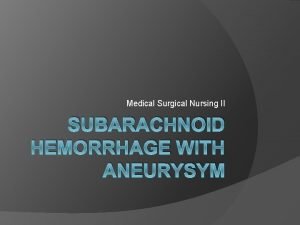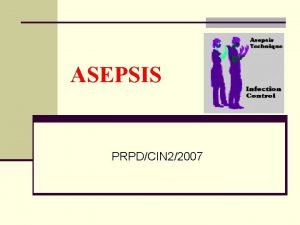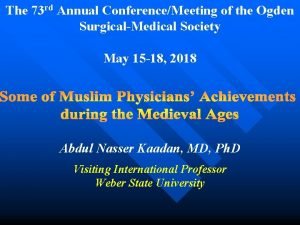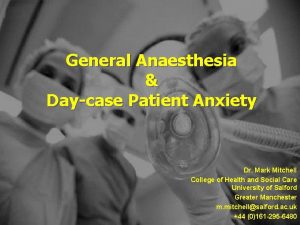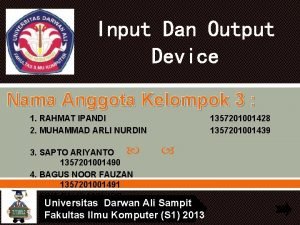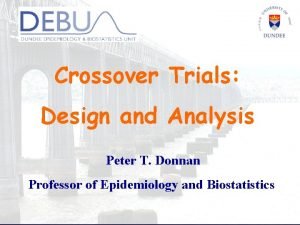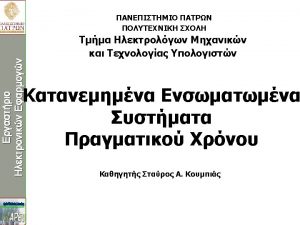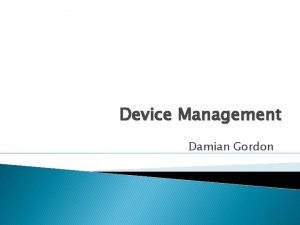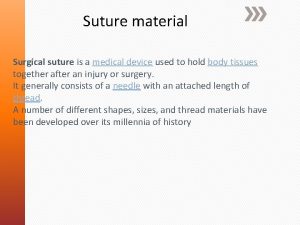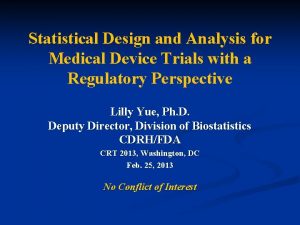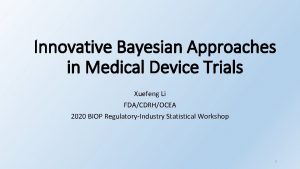CONSIDERATIONS FOR SURGICAL MEDICAL DEVICE TRIALS Considerations for











- Slides: 11

CONSIDERATIONS FOR SURGICAL MEDICAL DEVICE TRIALS Considerations for Medical Device Trials LCTU Liverpool Clinical Trials Unit

What are Medical Devices? • A medical device is an instrument, apparatus, implant, in vitro reagent, or similar or related article that is used to diagnose, prevent, or treat disease or other conditions through a combination of mechanical, electronic and chemical biochemical action(s) • Although, a medical device does not achieve it intended effect through a pharmacological, immunological or metabolic means; it can be assisted by such a process i. e. drug-eluting stents • All medical devices must have a CE mark for use within the EU and are covered by the following Directives: • Medical Devices Directive (93/42/EEC) • Active Implantable Medical Devices Directive (90/385/EEC) • IVDMDD – In Vitro Diagnostic Medical Devices Directive (98/79/EC) LCTU Liverpool Clinical Trials Unit

CE Marking and Classification Medical Devices • To obtain a CE Mark; a Medical Device must fulfil the essential requirements of the directive it falls as documented by a conformity assessment. The appropriate conformity assessment route is dependant upon the classification of the medical device. • The classification of medical devices’ is a risk based system and not all classifications require to undergo testing within a clinical investigation to obtain a CE mark. • Classification of a medical device will depend upon a series of factors, including: • how long the device is intended to be in continuous use • whether or not the device is invasive or surgically invasive, • whether the device is implantable or active • whether or not the device contains a substance, which in its own right is considered to be a medicinal substance and has action ancillary to that of the device. LCTU Liverpool Clinical Trials Unit

CE Marking and Classification Medical Devices • The manufacturer will make the initial assessment to determine the classification of their product and carry out the appropriate conformity assessment to obtain a CE marking. • Unless safety and performance can be adequately demonstrated by other means, data generated from a specifically designed clinical investigation of a medical device is likely to be required, . Such an investigation must be designed to: • verify that under normal conditions of use the performance characteristics of the device are those intended by the manufacturer; and • determine any undesirable side effects under normal conditions of use and assess whether these constitute risks when weighed against the intended performance of the device LCTU Liverpool Clinical Trials Unit

Clinical Investigations with Medical Devices • However, within Europe, high-risk devices only have to establish safety and performance and do not have to prove they make a difference to patients. • With the number of devices being recalled every year, within the UK and Europe, there is call to review the current Medical Device Directive • The current proposed version of the Medical Device Directive with its amendments is looking for clinical data on efficacy preferably obtained through randomised controlled trials (RCT) before marketing approval. • A situation which is standard for new medicines but is new for medical devices LCTU Liverpool Clinical Trials Unit

Challenges in Designing Clinical Investigations of Medical Devices • Devices are primarily used by healthcare professionals: The clinical outcomes of a medical device’s safety and effectiveness are a function of the user’s skill paired with the device-patient interaction. Having training in the use of the medical device is a key part of its clinical performance. • Inability to blind the user/patient: Medical devices are often designed differently and this can introduce bias into the assessment of the clinical performance if the clinical investigator is jointly responsible for treatment and assessment of performance. Thus, whenever possible, blinded evaluators are preferred to clinical investigators for the assessment of efficacy. LCTU Liverpool Clinical Trials Unit

Challenges in Designing Clinical Investigations of Medical Devices • Limitation in comparative trial design (e. g. , an implanted device): Comparative clinical trials may be precluded due to ethical considerations. The use of historical controls in the trial or patients as their own controls (pre- and post-surgery) may be required to evaluate outcome • Limitation with Device: • Some endpoint definitions in device trials may vary from device to device (e. g. , AF burden calculation • Memory capacity may lead to missing episodes and may lead to inaccurate information • Device date stamp resets may lead to inaccurate information re: endpoints LCTU Liverpool Clinical Trials Unit

Positives in Designing Clinical Investigations of Medical Devices • More precise endpoint determination due to electronic information storage on device • Compliance is easier to measure in device trials than in drug trials • Consideration of recurrent episodes may provide increased statistical power and hence fewer patients • Device trials offer more opportunity to be Bayesian – lots of prior information re: pacemakers and defibrillators • Device implant studies drive revenue much more than prescription drug trials LCTU Liverpool Clinical Trials Unit

Theory of the Sentinel Node or Nodes • Primary tumour initially drains to a specific lymph node(s) in the regional lymphatic chain • The first echelon sentinel node LCTU Liverpool Clinical Trials Unit

Sentinel Node Biopsy LCTU Liverpool Clinical Trials Unit

Sentinel Node Biopsy in Breast Ca 516 evaluable pts – all isotope alone (5 -10 Mbq of technetium/albumin) 96% detection rate Axillary pain: SNB 8% v 39% Clearance Numbness: 2% v 85% Arm swelling >1 cms: 0% v 37% No difference in axillary recurrence at 5 years LCTU Liverpool Clinical Trials Unit
 Cpu output device
Cpu output device Aneurysym
Aneurysym Asepsis
Asepsis Ogden surgical medical society
Ogden surgical medical society Difference between medical and surgical asepsis
Difference between medical and surgical asepsis Conclusion of medical surgical nursing
Conclusion of medical surgical nursing A tagout device is preferable to using a lockout device.
A tagout device is preferable to using a lockout device. Input device dan output device
Input device dan output device Design and analysis of cross-over trials
Design and analysis of cross-over trials Salem witch trials facts
Salem witch trials facts Site initiation visit agenda
Site initiation visit agenda Many kids called unfit for adult trials
Many kids called unfit for adult trials

